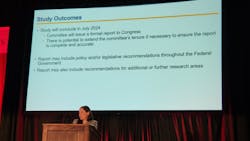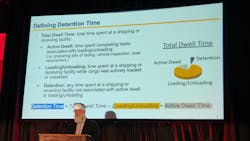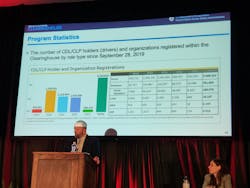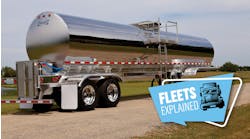LOUISVILLE, Kentucky—As detention time remains an ongoing issue and pay concerns rise in the shadow of persistent inflation, the Federal Motor Carrier Safety Administration updated industry stakeholders here at the Mid-America Trucking Show on its studies into these driver-focused issues. The agency also addressed upcoming Drug & Alcohol Clearinghouse changes and its efforts to inform drivers and carriers about how they are expected to comply.
Driver compensation
FMCSA is required to study driver compensation and its effects on safety as part of the Infrastructure Investment and Jobs Act (IIJA). The host of a panel discussion here, Tom Keane, who is FMCSA's associate administrator in its Office of Research and Registration, advised: “Set the blueprint for the safety work of the next five to six years.”
FMCSA entered a contract with the Transportation Research Board (TRB) to conduct a study on the impacts of various methods of driver compensation on safety and driver retention, including hourly pay and payment for detention time. FMCSA is sponsoring the study, but TRB is an independent body under the National Academy of Sciences, a private, nongovernmental institution established to advise the nation on issues related to science and technology.
“What we’ve heard from Congress is that the rationale for this study is really to look at ways to address potentially unsafe working conditions for the industry or unfair working conditions in the industry,” said Nicole Michel, FMCSA mathematical statistician.
Michel characterized the driver-compensation study as “unique to some of our other studies that we’ve conducted” because it's being done by independent experts with a committee of TRB. She emphasized that FMCSA is merely the study’s sponsoring agency, that it does not see any draft materials nor committee deliberations, and that all correspondence between FMCSA and committee members is subject to public record. FMCSA has no say on who is nominated to the TRB committee.
Of the committee members, only one has truck driving experience: Stephen Burks, a professor of economics and management at University of Minnesota-Morris. Michel said that, by rule, committee members can’t have a financial stake in the topic they are studying; otherwise, it would be viewed as a conflict of interest, she said.
On Jan. 18, the committee heard from an array of academic, government, and industry experts, including representatives of the American Transportation Research Institute (ATRI) and the Owner-Operator Independent Drivers Association (OOIDA). The ATRI experts conveyed the importance of driver compensation to the board, stressing that it was the No. 3 concern of drivers in 2022, according to its research. OOIDA criticized trucking’s long-standing pay-by-mile structure, saying it passes the industry’s inefficiencies onto the driver.
The driver-compensation study is set to conclude in July 2024. The TRB report will be peer-reviewed by a group of independent experts.
Detention time
FMCSA also is studying driver detention time as part of the IIJA. Jonathan Mueller, chief of FMCSA’s research division, said detention time “was and continues to be a high-priority issue.”
According to FMCSA’s research, detention time costs drivers $1.1 billion to $1.3 billion in lost wages per year and the industry loses $3 billion to $6.5 billion in driving time each year.
Previous FMCSA studies relied on the unofficial industry standard definition of detention time, in which a driver spends more than two hours waiting on loading or unloading. But according to a 2014 study, which used third-party vendors’ GPS data to track detention time, 11% of all stops exceeded two hours—by 1.4 hours on average.
However, according to Mueller, that “Phase I” study was limited. The study was not able to differentiate loading and unloading time from wait times, whichFMCSA’s website states is “a critical data gap in our understanding of the detention issue."
Mueller also said the study’s six-month widow was too short. He cited a limited “stratification of variables,” meaning the study did not look closely enough at factors such as the size and design of facilities. He also said previous studies’ reliance on GPS data was limiting and that future studies are planned to use intelligent transportation systems (ITS) data, such as from fleet telematics and onboard monitoring and safety systems.
Research questions include: how driver detention time fluctuates based on the time of day, day of week, and time of year; how does driver detention time affect crash likelihood, HOS violations, or fatigue; what the costs of driver detention time are; what are potential mitigation strategies; are currently available ITS systems able to measure detention time; do vehicles with appointment times experience less detention time; are differences in the definition of detention time a problem for the industry; and how does detention time at port terminals compare to other facilities.
The final report is planned to release July 2025 and “the data collection plan is still being formalized,” Mueller said.
Clearinghouse
Bryan Price, FMCSA's chief of its North American Borders Program Division, discussed ongoing Drug & Alcohol Clearinghouse changes, including phase two of the Clearinghouse final rule, which would connect clearinghouse results to state DMVs and the process of drivers returning to duty after a violation.
After a clearinghouse violation, Price said three-fourths of drivers do not go through the return-to-duty process, which requires work with a substance abuse professional. After the substance abuse professional determines the driver is eligible to return to duty, the driver's employer orders another drug test. If the driver tests negative, the clearinghouse status will update to "not prohibited," and the driver must complete a follow-up testing plan.
“I’m not going to say it doesn’t take work,” Price said, “but we’re a country of second chances.”
The second phase of the Clearinghouse final rule goes into effect Nov. 18, 2024. After that point, Clearinghouse status will be communicated to state DMVs and drivers will be unable to receive, renew, or transfer a CDL or learner’s permit, and their commercial driving privileges will be revoked. Privileges will be reinstated if a driver’s clearinghouse status changes to “not prohibited” after completing the return-to-duty process.
Price said that, although FMCSA already can revoke commercial drivers’ ability to drive, many carriers don't checke the clearinghouse. Even if a carrier is not checking drivers’ CDL status as it should, by suspending CDLs at the state level, insurance companies will check, which will bring the revoked status to the employer’s attention.
Price underscored that, regardless of its legal status in a driver's home state, marijuana use is still prohibited by federal law and can result in being placed out-of-service via Clearinghouse rules. Cannabis is by far the most common Clearinghouse violation.
"Marijuana, if you want to be a commercial driver, it's still a no-go," Price said.
Price said that, if cocaine, methamphetamines, and amphetamines are added up, they appear in about one in three tests. He added that a "fair number" of drivers have violations with multiple substances simultaneously.







